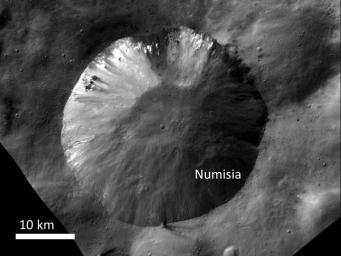Bright Material at Numisia Crater
Caption:
This image from NASA's Dawn spacecraft shows the crater Numisia, located just south of the equator in the Numisia quadrangle on Vesta. Bright material appears in various forms on Vesta, and is mostly associated with large fresh craters. This material can be seen on the walls of Numisia in this image.
The image was obtained by Dawn's framing camera on Oct. 21, 2011, during high-altitude mapping orbit (on average 420 miles or 680 kilometers above Vesta's surface). This particular image was taken at 435 miles or 700 kilometers above the surface. It covers about 1,200 square miles (3,000 square kilometers).
Background Info:
The Dawn mission to the asteroids Vesta and Ceres is managed by NASA's Jet Propulsion Laboratory, a division of the California Institute of Technology in Pasadena, for NASA's Science Mission Directorate, Washington. Dawn is a project of the directorate's Discovery Program, managed by NASA's Marshall Space Flight Center in Huntsville, Ala. UCLA is responsible for overall Dawn mission science. The Dawn Framing Cameras have been developed and built under the leadership of the Max Planck Institute for Solar System Research, Katlenburg-Lindau, Germany, with significant contributions by DLR German Aerospace Center, Institute of Planetary Research, Berlin, and in coordination with the Institute of Computer and Communication Network Engineering, Braunschweig. The framing camera project is funded by the Max Planck Society, DLR, and NASA/JPL.
More information about the Dawn mission is online at
http://www.nasa.gov/dawn
and
http://dawn.jpl.nasa.gov
.
Cataloging Keywords:
| Name |
Value |
Additional Values |
| Target |
4 Vesta |
|
| System |
Main Belt |
|
| Target Type |
Asteroid |
|
| Mission |
Dawn |
|
| Instrument Host |
Dawn |
|
| Host Type |
Orbiter |
|
| Instrument |
Framing Camera (FC) |
|
| Detector |
|
|
| Extra Keywords |
Crater, Grayscale |
| Acquisition Date |
|
| Release Date |
2012-03-21 |
| Date in Caption |
2011-10-21 |
|
| Image Credit |
NASA/JPL-Caltech/UCLA/MPS/DLR/IDA/UMD |
| Source |
photojournal.jpl.nasa.gov/catalog/PIA15234 |
| Identifier |
PIA15234 |

 Planetary Data System
Planetary Data System
